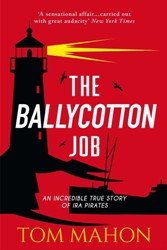 Pirates and Privateers Pirates and Privateers
The History of Maritime
Piracy
Cindy Vallar, Editor
& Reviewer
P.O. Box 425,
Keller, TX 76244-0425
    
Books for
Adults ~ Modern Piracy

The Ballycotton Job: An Incredible True Story of IRA
Pirates
by Tom Mahon
Mercier Press, 2022, ISBN 978-1-78117-443-2, US $17.99
/ EUR €14.99
Also available in other formats
    
Before 1922, Royal Navy
ships frequently docked at Queenstown,
Ireland (known as Cobh today) for repairs
and to take on supplies. This began to
change in January of that year when the
Anglo-Irish Treaty was ratified. Instead
of overseeing naval operations, Admiral
Sir Ernest Gaunt started shutting down
British naval bases and arranging for
soldiers to be evacuated. Normally
unshakable, disciplined, and logical, he
was now unduly tense and thoroughly
despised Ireland. He believed those who
supported Irish independence, particularly
the Irish Republican Army (IRA), were
simpleminded killers who lacked the
ability to plan and execute military
operations.
About eight miles to the northwest lay
Cork, a major port for merchant and
passenger ships. The city was the home of
Seán O’Hegarty, commander of the Cork No.
1 Brigade, a large and highly efficient
unit within the IRA. Contrary to Gaunt’s
belief, O’Hegarty was quite adept at
arranging ambushes and skirmishes with
great success and minimal losses. He
showed no fear, cared little for his own
well-being, and led from the front.
Ruthless, clever, and resolute, he had a
single goal: Irish independence. If that
meant provoking war, so be it.
With the dismantling of the naval bases,
there were untried opportunities for
O’Hegarty to launch a pivotal attack. He
settled on a bold plan that involved
kidnapping and piracy, even though the key
participants possessed little, if any,
knowledge of ships and the sea. “Any
reasonable and rational commander would
have dismissed the undertaking as
foolhardy in the extreme. Not only was the
underlying premise overly optimistic, but
the project entailed an elaborate sequence
of actions, each dependent on the other
and should one component fail then the
whole operation would fail.” (129-130) Not
one to back down, O’Hegarty refused to be
dissuaded and the isolated village of
Ballycotton became the “X” on the treasure
map.
This is the astounding story of how
O’Hegarty seizes a navy transport, laden
with ammunition, explosives, and weapons,
on 30 March 1922. Mahon skillfully answers
questions of who, what, when, where, why,
and how in a manner that reads more like
an adventure novel than a recitation of
facts. To enhance the reading experience,
he delves into a variety of interrelated
subtopics (such as violence, prejudice,
and colonialism) and discusses the
aftermath of the incident and what became
of the people involved in or affected by
it. Also included are maps, a glossary,
notes and references, and a bibliography.
The Ballycotton Job is a must-read
for anyone wishing to know about the
turbulent struggle for Ireland and the
Irish to be free of British rule in the
early 20th century.
Review Copyright ©2022
Cindy Vallar

Click to contact me
Background image compliments
of Anke's Graphics |

